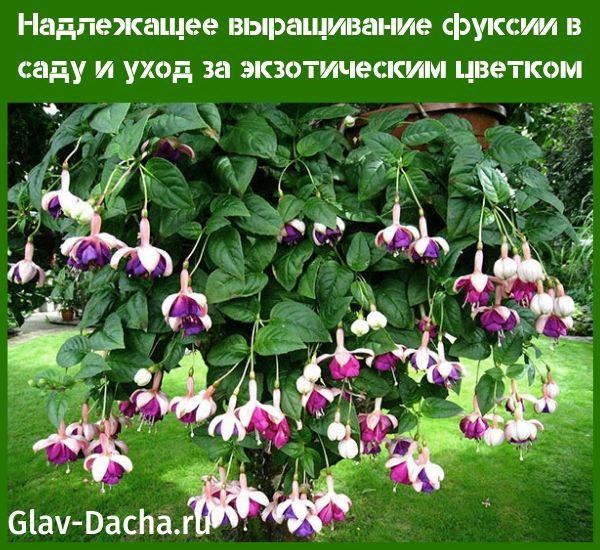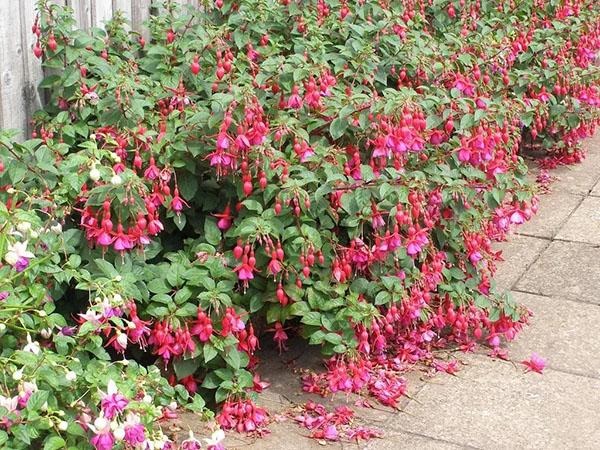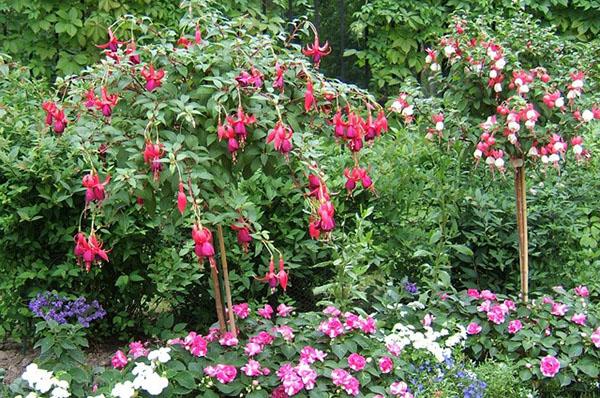Properly growing fuchsia in the garden and caring for an exotic flower
 A luxurious flower known under the secret name "Japanese lantern" will help the gardener to decorate the front garden near the house in an oriental style. Growing fuchsia in the garden and caring for it is loved by millions of gardeners. She is unpretentious and feels great in a flower bed. Since garden fuchsia is a hybrid, it is important to create the right conditions for it. For this, it is important to know the intricacies of planting and caring for a flower.
A luxurious flower known under the secret name "Japanese lantern" will help the gardener to decorate the front garden near the house in an oriental style. Growing fuchsia in the garden and caring for it is loved by millions of gardeners. She is unpretentious and feels great in a flower bed. Since garden fuchsia is a hybrid, it is important to create the right conditions for it. For this, it is important to know the intricacies of planting and caring for a flower.
Growing and caring for fuchsia in the garden


Growing fuchsia in the garden and caring for it is impossible without observing 4 rules:
- Comfortable temperature should be in the range of 20-25˚С, and in winter - 5-10˚С. Hypothermia will destroy the plant.
- Place the culture in slightly shaded and calm areas. Direct sunlight causes burns on buds and leaves.
- For perennial garden fuchsia, fertile soil with a neutral reaction is chosen.
- Exclude the proximity of an exotic beauty with other flowering plants, except for bushes and trees. Otherwise, one of them will surely die.
Deficiency of moisture leads to shedding of leaves and buds of fuchsia, as well as wilting of the entire flower.
 In some cases, farmers sow ornamental crop seeds for seedlings in February-March. Expanded clay / pebbles are spread at the bottom of the transparent container. Then the prepared soil mixture is unloaded, having previously disinfected the ground, and compacted. The surface of the soil is sprayed with a solution of potassium permanganate. The seeds are deepened by 3-5 cm, covered with glass, leaving a hole for ventilation.
In some cases, farmers sow ornamental crop seeds for seedlings in February-March. Expanded clay / pebbles are spread at the bottom of the transparent container. Then the prepared soil mixture is unloaded, having previously disinfected the ground, and compacted. The surface of the soil is sprayed with a solution of potassium permanganate. The seeds are deepened by 3-5 cm, covered with glass, leaving a hole for ventilation.
 The container is placed in a well-lit place at a temperature not exceeding 22˚С. The air around the planting is sprayed daily. When the first shoots appear, they begin to moisten the ground every 2 days. At the end of spring, seedlings are transplanted into a pot and taken out to a flower bed.
The container is placed in a well-lit place at a temperature not exceeding 22˚С. The air around the planting is sprayed daily. When the first shoots appear, they begin to moisten the ground every 2 days. At the end of spring, seedlings are transplanted into a pot and taken out to a flower bed.
Correct planting of fuchsia in the garden
 In the middle lane, planting is planned for late May or early June, since it is thermophilic. Rooting in a new place is fast. After 2-3 weeks, the first buds appear. Fuchsia planting and flower care are carried out using a fairly simple technology. The seeding depth of the root collar of the culture is no more than 20 cm.
In the middle lane, planting is planned for late May or early June, since it is thermophilic. Rooting in a new place is fast. After 2-3 weeks, the first buds appear. Fuchsia planting and flower care are carried out using a fairly simple technology. The seeding depth of the root collar of the culture is no more than 20 cm.
To give the soil structure, gardeners bring to the garden or pot:
- peat;
- sand;
- sod land;
- perlite;
- clay.
 The ratio of the first 3 components should be 2: 1: 3. The rest of the components are made at their discretion. The unique properties of clay soil are that it retains nutrients in the soil for a long time. Compost, rotted manure and phosphate fertilizers guarantee the full growth of the crop.
The ratio of the first 3 components should be 2: 1: 3. The rest of the components are made at their discretion. The unique properties of clay soil are that it retains nutrients in the soil for a long time. Compost, rotted manure and phosphate fertilizers guarantee the full growth of the crop.
Fuchsia is dug from the flower bed after the first frost. Such hardening will help the shrub to fully enter the period of winter dormancy.
Fuchsia transplant, which is more than 3 years old, is carried out very carefully so as not to damage the root system.In addition to peat and sand, sod or deciduous soil is added to the soil substrate. The moisture content of the soil mixture is kept stable. Do not allow the top layer to dry out, as well as stagnation of moisture in the lower part of the pot.
Painstaking care for garden fuchsia
 The main requirement for growing a crop is abundant but moderate watering. At normal air temperature, the procedure is carried out every 2-3 days in the morning or evening hours. Since fuchsia loves moisture, the flower is sprayed daily. In order for the plant to delight the gardener with its bright color and lush greenery, fertilizers are regularly applied to the soil.
The main requirement for growing a crop is abundant but moderate watering. At normal air temperature, the procedure is carried out every 2-3 days in the morning or evening hours. Since fuchsia loves moisture, the flower is sprayed daily. In order for the plant to delight the gardener with its bright color and lush greenery, fertilizers are regularly applied to the soil.
The type of feeding depends on the phase of development of fuchsia:
- Saplings. Nutrient complexes with a high nitrogen content accelerate the growth of stems and green mass.
- Young plants. Potassium-phosphorus fertilizers (Fertika, Pokon or Kemira Lux) are used to form a large number of buds.
- During the flowering period. After the appearance of the first ovaries, the mineral complex "Bud" is used. Compositions containing manganese, iron, zinc and magnesium are also used.
The peat oxidant preparation is applied for intensive nutrition of leaves with useful substances. The solution (1%) promotes the formation of new shoots and strong greenery.
 The photo of the garden fuchsia flower shows several popular varieties of culture. For their summer cottage, many choose only hybrid varieties of a flower.
The photo of the garden fuchsia flower shows several popular varieties of culture. For their summer cottage, many choose only hybrid varieties of a flower.
More than 100 of its types can be divided into 4 main classes:
- Australian. Tall shrubs Valsing and Matilda are used as hedges.

- Ampelny. Famous varieties of Alice Hoffman (or Ashton), as well as the Cascade, decorate the facades of houses.

- Terry. The lush flowers of Florentina and Paula Jane will luxuriously decorate the garden.

- Sapphire. The unique combination of blue and white in Ultramarine or Capri will bring elegance to the exterior.

Fuchsia garden pliable to pruning. Shortening of the bush is carried out at the end of the growing season. In October, faded branches are cut off at a height of 2 cm from the dormant bud. The formation of the crown is planned for January. The plant is given a standard, ampel, bush or pyramidal shape. Thanks to this growing fuchsia in the garden and caring for it, truly decorative specimens are obtained. Such works of garden art become the real property of the dacha.